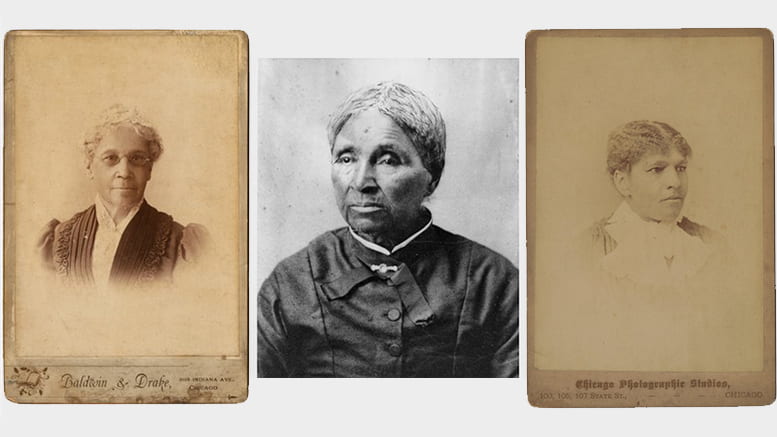New exhibit explores how Black women pushed for equality in 19th century America
March 18, 2022

A new virtual exhibit details Black political mobilizations in pre-Civil War Illinois, including the crucial contributions of Black women
While Black men inhabited the most visible, public-facing positions of Black life in mid- 19th century America, the male ministers, editorial writers, and orators were not the only ones championing a more just, fair-minded society.
Black women, Northwestern history professor Kate Masur reminds, played critical, though often untold, if not wholly overlooked, roles in the humanistic effort. Black women sheltered slaves escaping the South on the Underground Railroad, created the infrastructure for churches and schools, operated boarding houses, and founded justice-minded organizations. Their efforts sparked emancipation, heightened education, spurred upward mobility, and improved the quality of life for Black residents in Illinois and elsewhere across the country.
“In a dynamic time with questions swirling about universal rights and the opportunity to thrive in society, Black women pushed for racial justice in important, profound ways,” Masur says.
Detailing Black organizing
Masur and a team of student researchers spent more than two years investigating Black political mobilization in mid-19th century America, including the integral roles women filled in and out of their homes. Supported by Northwestern staff with expertise in the Digital Humanities, that work now lives in a recently launched virtual exhibit.
“Black Organizing in Pre-Civil War Illinois: Creating Community, Demanding Justice” profiles the struggle for racial justice in Illinois’ earliest decades, covering topics such as the making of Black Chicago, Black life in Antebellum Illinois, and the Illinois Colored Convention of 1853 headlined by keynote speaker Frederick Douglass.
The digital exhibit is part of a broader, interdisciplinary effort called the Colored Conventions Project (CCP) directed by Penn State University’s Center for Black Digital Research. The CCP features interactive historical exhibits detailing the fight for civil and human rights among Black Americans in the 19th century.
Showcasing Black women
Affirming Black women’s centrality to early Black organizing sits among the CCP’s five core principles, especially as many official records erase or anonymize women’s key labor and leadership roles. That reality shines in the Masur-led project, which highlights women such as:
- Mary Richardson Jones, president of the Colored Ladies’ Freedmen’s Aid Society, which collected funds and supplies for newly liberated people in the South.
- Mary E. Mann, the first Black high school graduate in Chicago and the first African American to work in a Chicago public school.
- Sattie Douglas, an abolitionist activist who contributed to prominent Black newspapers and taught in schools for freedpeople.
- Anna Elizabeth Hudlin, an active member of Quinn Chapel A.M.E. and the Underground Railroad, who also fought school segregation in Chicago in 1863.
- Eleanor Madden Johnson, who founded a farm with her husband that remained in the family’s possession for generations.
Delivering inspiration
Weinberg College junior Shira Nash, one of several student researchers who worked alongside Masur, says the “Black Organizing” project underscores the critical roles Black women played in supporting and uplifting households as well as community institutions like churches and schools.
“As a young Black woman, it was interesting to see the ways in which my ancestors made strides for the life I lead today,” says Nash, a sociology major from Washington, D.C. “Their dedication to others, faith, and activism was paramount during these times and truly inspiring.”
In highlighting the contributions of Black women during this heated period in American history, Masur and her team hope to foster a “more democratic vision of history.”
“In sharing a fuller picture of history and telling stories people can see themselves in, we hope to enlighten and empower,” Masur says.
Explore the digital exhibit here.

Society & Policy

Joel Mokyr wins Nobel Prize in Economic Sciences
October 13, 2025
Nobel recognizes Mokyr’s theory on sustained economic growth Joel Mokyr, the Robert H. Strotz Professor of Arts and Sciences and professor of economics and history in the Weinberg College of Arts and Sciences at Northwestern University, today (Oct….

Weinberg College faculty and graduate students recognized for excellence in teaching
July 2, 2025
Each year, the Weinberg College of Arts and Sciences and the Office of the Provost recognizes members of the College’s tenure-line and teaching-track faculty for excellence in teaching. Weinberg College in addition recognizes the contributions…

Passion for the planet: A new generation of environmental stewards starts here
May 29, 2025
Over the last two decades, the Weinberg College-housed Program in Environmental Policy and Culture (EPC) at Northwestern has embraced the humanities and social sciences and cultivated a new generation of environmental stewards. Growing up in…

The real beneficiaries of protective labor laws for women
May 20, 2025
During the first half of the 20th century, many states passed labor laws in response to the influx of women into the modern workplace. The so-called protective labor laws enacted by U.S. states restricted women’s…



